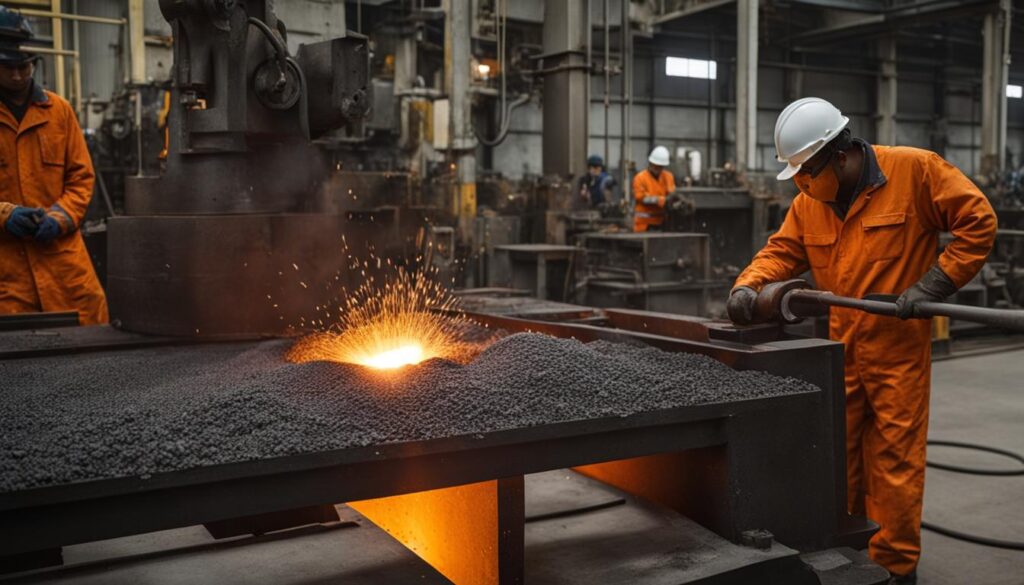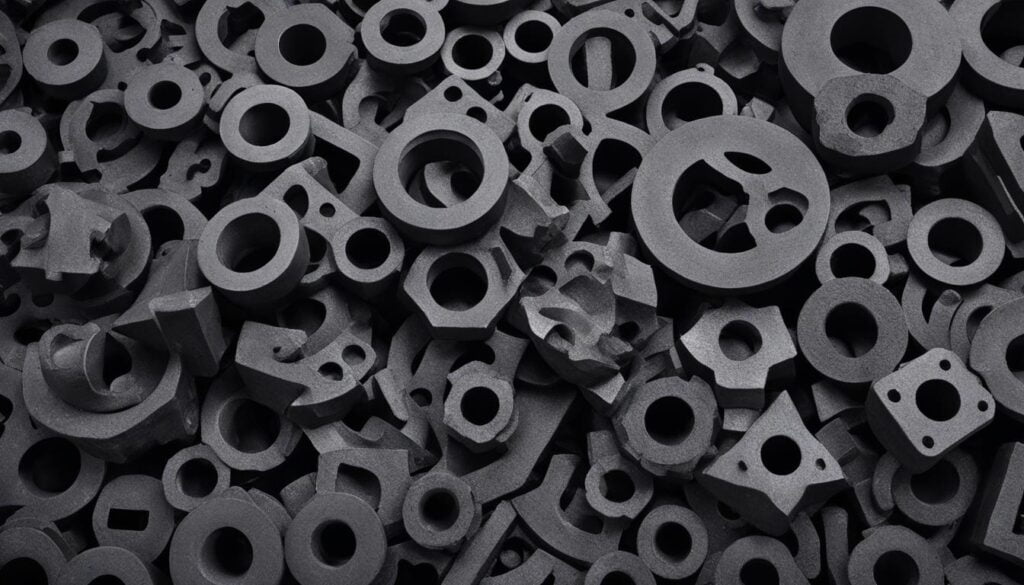At KT-Foundry, we recognize the paramount significance of gray iron in the manufacturing and engineering sectors, wherein its attributes of casting strength, industrial durability, and material versatility are highly valued. Gray iron’s history as a material of choice stretches back centuries, evident in its prevalent use across a spectrum of products from automotive components to architectural details. It is the inherent qualities, such as excellent castability, commendable machinability, and superior damping capacities — a result of the graphite flakes in its structure giving it a distinct gray hue — that anchor its widespread utilization. Applications such as engine blocks, pipes, manhole covers, and brake discs are testament to gray iron’s indispensable role in industrial applications.
Key Takeaways
- Gray iron is prized in manufacturing and engineering sectors for its castability, machinability, and dampening capabilities.
- The unique graphite flake structure creates its characteristic gray color and strength.
- Gray iron castings are widely used in applications such as engine blocks, pipes, manhole covers, and brake discs due to their industrial durability and material versatility.
- KT-Foundry is committed to providing high-quality gray iron castings while maintaining cost-efficiency and performance.
- Gray iron remains a top material choice in modern manufacturing due to its proven ability to fulfill diverse industrial demands.
Gray Iron Castings: The Foundation of Industrial Strength
Gray iron castings serve as the cornerstone of industrial strength, offering an optimal amalgamation of formability, machinability, and function. This type of cast iron affirms its dominance in the casting field due to factors such as its gray coloration attributed to the unique graphite flake microstructure. Encompassing a diversity of applications, gray iron castings are integral to the production of essential components like engine blocks that benefit from its thermal conductivity and capability to dampen vibration. In the realm of public utilities, one can see its applications in the form of sturdy, load-bearing manhole covers. Similarly, the automotive sector relies on this versatile material for robust brake discs that capitalize on gray iron’s capacity to withstand high temperatures and dissipate heat swiftly.
Why gray iron is the go-to material in diverse industries
As a result of its exceptional properties, high-quality gray iron dominates the casting industry, making its presence palpable in various industrial cast iron products.

- Engine Blocks – Owing to the excellent thermal conductivity and machinability of gray iron, it is ideal for producing engine blocks.
- Brake Discs – In the automotive industry, gray iron can effectively dissipate heat and endure high temperatures, making it perfect for brake discs.
- Manhole Covers – Given its strength and durability, gray iron is widely used to create sturdy and long-lasting manhole covers for public utilities.
Gray iron applications don’t cease with these examples; they permeate across various industries, exhibiting the sheer versatility of this robust material. The unparalleled casting industry strength of gray iron makes it irreplaceable, ensuring the continuous production of industrial cast iron products that cater to a myriad of requirements.
A Deep Dive into the Diverse World of Cast Iron
As experts in iron castings, KT-Foundry acknowledges the multifaceted nature of the cast iron family. By exploring the industry-revered qualities of gray iron, comparing ductile and malleable iron, and examining the role of white iron in high-wear applications, we strive to deliver optimal solutions tailored to specific industrial demands and applications.
Industry-Revered Qualities of Gray Iron
Embracing the industry-revered qualities of gray iron, KT-Foundry champions this material for its outstanding castability, ensuring a smoother production process and intricate detailing without compromising the material’s integrity. Furthermore, the machinability of gray iron is of paramount importance, allowing for seamless alterations and finishing which contributes significantly to cost-efficiency in manufacturing. The presence of graphite flakes is not merely for aesthetics; these flakes are central to gray iron’s renowned dampening capacity, vital in applications where vibration control is pivotal, such as in machinery bases and engine blocks.
Comparing Ductile and Malleable Iron: Strengths and Uses
Acknowledging the multiplicity within the cast iron spectrum, KT-Foundry highlights the superior toughness and ductility of ductile iron that stem from trace magnesium or cerium content, leading to graphite nodules in its microstructure. This variation of iron casting manifests a strength similar to that of steel but retains the processing advantages of standard cast irons. Ductile iron castings are notably used in applications demanding resilience such as gears and heavy machinery parts. In contrast, malleable iron, which evolves through heat treatment of white iron, merges robustness with malleability and is readily machineable; hence its use in segments like pipe fittings and hand tools.
The Role of White Iron in High-Wear Applications
White iron castings have a niche role in applications subject to severe wear and tear. White iron’s naming convention is twofold, based on not only its color but also its high cementite content which bestows a distinct hardness and brittleness. This nature of white iron comes into play in scenarios where durability against abrasion is non-negotiable, exemplified in machinery like crushers and pumps, grinding balls, and excavator teeth. Here at KT-Foundry, we venerate the wear resistance of white iron castings as an asset in designs marked by high wear conditions.
Casting Suppliers: The Unsung Heroes Behind Quality Iron Castings
At the foundation of KT-Foundry’s esteemed casting products are the partnerships with proficient casting suppliers, who are instrumental in sourcing the highest quality materials. Their expertise ensures that the gray iron used meets stringent standards, positioning our products at the apex of performance. The suppliers’ vigilance in procuring materials not only reinforces the caliber of the end product but also embodies our commitment to deliver iron castings that are consistent in excellence.

Sourcing Superior Materials for Optimal Performance
Raw materials play a crucial role in elevating the performance of quality iron castings. By forging strategic alliances with top-tier casting suppliers, KT-Foundry is dedicated to attaining materials that demonstrate unwavering strength, durability, and resilience. This commitment to quality extends across our entire range of iron casting products, ensuring that both the materials and the final products are tailored to meet industry-specific requirements.
Technical Assistance and its Impact on Casting Quality
Melding our casting process expertise with the technical assistance provided by our casting suppliers enables us to fine-tune our processes and troubleshoot with expert insight. This collaboration results in improved casting quality, reflecting a profound understanding of the intricacies involved in the casting process from raw material selection to the finished product. We prioritize continuous quality assurance at KT-Foundry, endowing our clients with cast iron products that are not just built to serve, but engineered to surpass expectations.
The Metamorphosis of Metal: Understanding the Casting Manufacturing Process
At KT-Foundry, we pride ourselves on our deep understanding of the casting manufacturing process, which plays a fundamental role in molding metal into a diverse array of industrial applications. This intricate process is marked by several pivotal stages, transforming metal from its molten state to the solid, geometric form that powers the modern world.
Every journey begins with a single step, and in the casting manufacturing realm, that step is the creation of a precise pattern. These patterns lend shape to the final product and serve as the blueprint for the entire process. From this initial stage, we proceed with the diligent preparation of molds, using either sand or refractory substances to accommodate the molten iron safely.
As the process continues, the iron is melted and poured into the prepared mold, transforming it on both a molecular and a visual level. Afterward, the cooling process commences, allowing the iron to solidify into the desired geometric configuration. With iron solidification complete, the product is carefully shaken out of the mold, signifying the completion of the casting process.
Finally, our products undergo a series of rigorous finishing procedures, including machining and surface treatments, which serve as the decisive factors for the final product’s quality and performance. This emphasis on finishing touches reflects our steadfast commitment to exceed expectations and deliver products of exceptional caliber.
It is through the meticulous execution of each stage in the casting manufacturing process that we at KT-Foundry affirm our authority in shaping cast iron’s destiny in industrial applications.
Conclusion
In the intricate world of modern manufacturing, gray iron castings continue to hold their ground as a crucial element, responsible for their accessibility, cost-effectiveness, and engineering properties. At the heart of their timeless relevance is their ability to provide strength, withstand demanding conditions, and consistently excel in various industrial applications.
Why Gray Iron Castings Remain a Pillar in Modern Manufacturing
Gray iron castings maintain their position as a powerful ally in the ever-evolving manufacturing landscape due to the balance they strike between performance, affordability, and versatility. These attributes solidify their importance in the industry and make them an indispensable resource in meeting the challenges faced by countless sectors.
The KT-Foundry Difference: Commitment to Casting Excellence
At KT-Foundry, our unwavering dedication to casting excellence sets us apart from the rest. We stand firm in our commitment to utilizing quality gray iron, adopting painstaking manufacturing processes, and pursuing continuous innovation. Driven by a spirit of customer satisfaction, we strive to create top-notch iron castings that are not only structurally sound but also outperform their intended purposes, making them ideal for conquering varied industrial terrains.
FAQ
What are the main advantages of gray iron castings?
Gray iron castings offer several benefits such as excellent castability, ease of machining, superior damping capacities, strength, durability, and versatility. These qualities make it highly valued in various industries such as automotive, manufacturing, and engineering.
What are some common applications of gray iron?
Gray iron is widely used in a variety of applications, including engine blocks, pipes, manhole covers, brake discs, machinery bases, and other components that require strength and vibration dampening properties.
How do ductile iron and malleable iron compare to gray iron?
Ductile iron has higher toughness and ductility due to its graphite nodules microstructure, making it suitable for applications demanding resilience like gears and heavy machinery parts. Malleable iron combines robustness with malleability and is readily machinable, often used in pipe fittings and hand tools. Both ductile and malleable iron serve different purposes compared to gray iron, which is known for its castability, machinability, and dampening properties.
What role does white iron play in high-wear applications?
White iron has a high cementite content, giving it a distinct hardness and brittleness suitable for applications subject to severe wear and tear. Its wear resistance is invaluable in machinery like crushers, pumps, grinding balls, and excavator teeth, where durability against abrasion is essential.
How do casting suppliers contribute to the quality of iron castings?
Casting suppliers play a crucial role in sourcing high-quality materials for manufacturing iron castings. Their expertise ensures that gray iron used meets stringent standards, positioning the products at the apex of performance. Moreover, casting suppliers provide technical assistance, enabling improved casting quality and understanding of the intricacies involved in the casting process.
What are the steps involved in the casting manufacturing process?
The casting manufacturing process at KT-Foundry begins with precise pattern making and mold preparation using either sand or refractory substances. Melting and pouring of molten iron follow, then cooling to solidify the metal into the desired geometric configuration. The solidification process is completed with shaking out, machining, and various surface treatments to ensure the final product’s quality.


